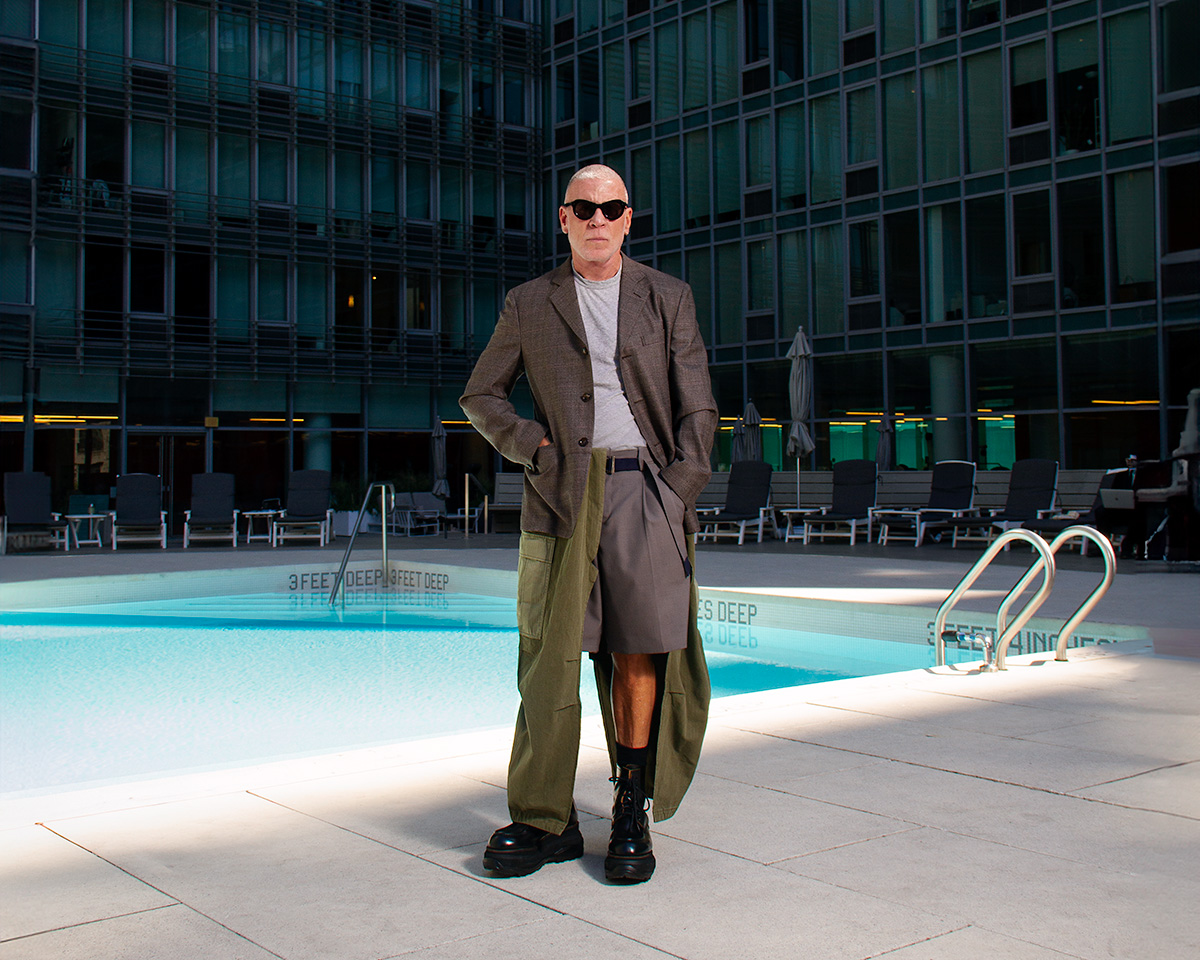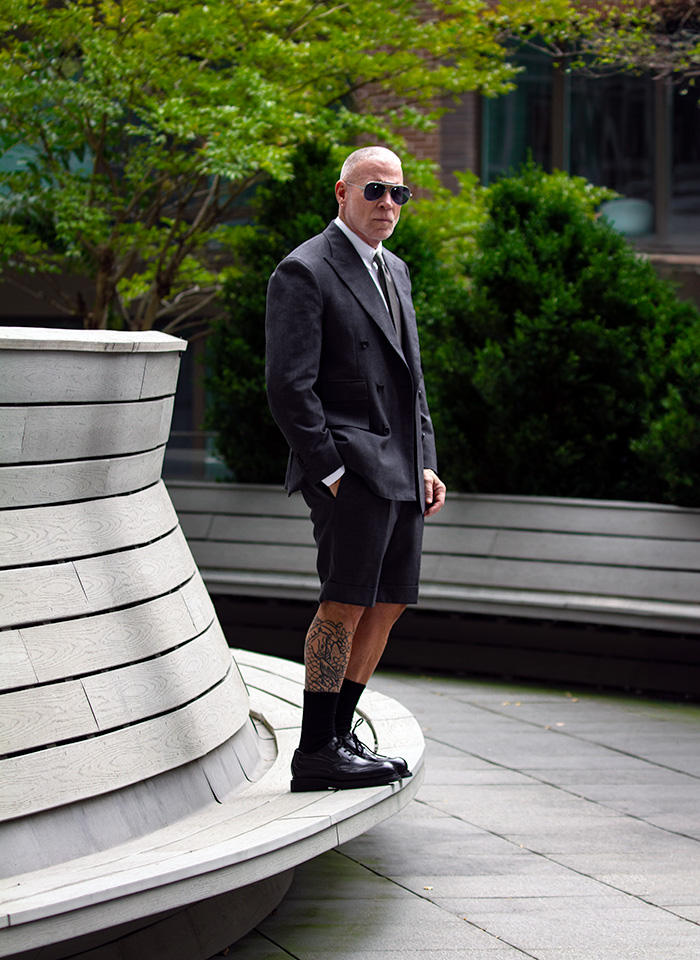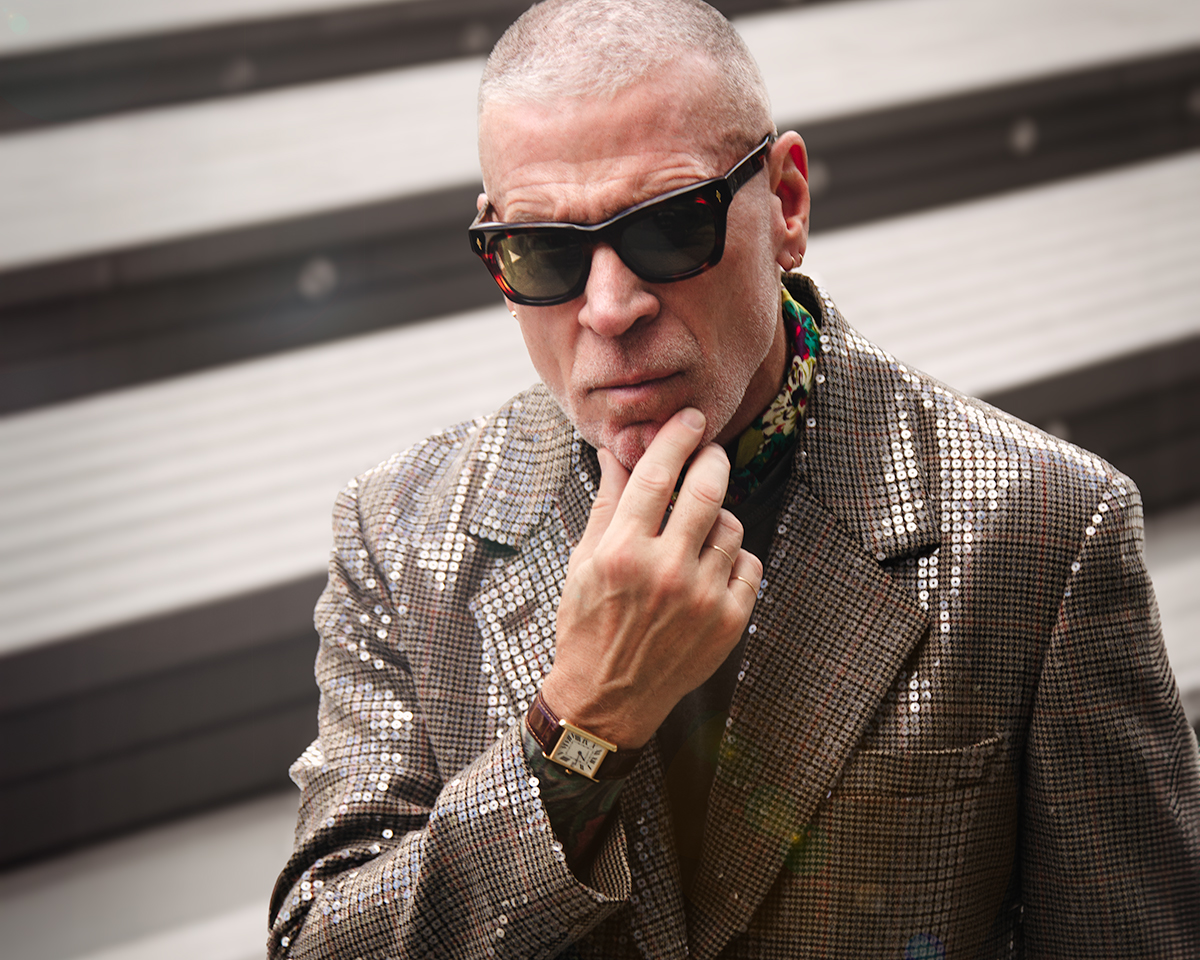FROM OUR NOVEMBER ISSUE: THE ACCIDENTAL INFLUENCER

The entire MR team proudly presents our November 2024 issue. If you haven’t received a hard copy, please page through our digital version, and we’ll continue to post individual stories here on MR-mag.com. If you haven’t been getting MR in print, be sure that you are on our mailing list for future issues by completing this form.
No one is more amazed than Nick Wooster, a self-described gay kid from Salina, Kansas, that he’s been buyer, manager, and fashion director at some of the most iconic stores in America. Now an “influencer,” content creator, and cover model, his is a story of following dreams, taking risks, persevering. Of seeking out mentors and learning as much as possible from each. Of believing in yourself, trusting your instincts, and realizing that setbacks can lead to opportunity. Soon to turn a milestone 65, Nick shares with MR some of what’s he’s learned over the years.

MR: So what is an influencer anyway?
Nick: I don’t know the official definition, or even how I got to be one. I suppose it means you have lots of followers on social media, and you’re able to drive a lot of business. For me, I was attending fashion shows for my job at Neiman’s, and a photo of me taken by photographer Tommy Ton ended up in Vogue!
So becoming an influencer was not your lifelong ambition?
It was not, although I always loved fashion. I grew up middle-class in Salina, Kansas. My dad was a mechanic who provided well for his family; following his example, I always worked. As a kid, I loved nice clothes, and (making my mother crazy) I had strong opinions as to what I’d wear, and what I wouldn’t. In high school, I was guided by Lisa Birnbach’s The Official Preppy Handbook. When I asked my mom for a cashmere sweater, she told me that she’d buy me a sweater but not a cashmere one. If I wanted luxury, I’d have to find a job to pay for it. She suggested I go to Joseph P. Roth & Sons, the nicest men’s store in town, and ask if they needed help. So at age 16, I started working there. I owe almost everything I know about men’s retailing to Charlie, one of the sons, who recognized in me a certain taste level. He’d say “Hey Nicky, fix those mannequins” or “Hey Nicky, we need some help with the Christmas windows.” When sales reps would come to the store, Charlie would call me over and ask my opinion on which were the best plaids. (We’d take coins out of our pockets and place them on our favorite swatches.) Recognizing a flair, he started taking me on buying trips: to Kansas City, Dallas, eventually NYC. I learned so much.
In college, I majored in advertising since it was the easiest path to graduation. I thought I was going to be Don Draper at a glamorous ad agency, but soon realized that selling space in New York magazine was a job for which I was completely ill-suited. I wanted to get into the Saks’ training program but when I learned they select only from Ivy League colleges, I settled for a job as an assistant department manager, with hopes of qualifying for the training program. But with my shoulder-length hair and unconventional style, I realized I’d never be chosen. As luck would have it, I heard that Peter Rizzo at Barneys was looking for an assistant. I applied, and (shockingly!) got hired, moving up to clothing buyer and learning so much. Peter was tough, demanding, and incredibly knowledgeable. I’m forever grateful to him and to the Pressman family for giving me the opportunity to learn. As clothing buyer for Barneys, I’d go with them to the mills in Italy to choose fabrics, then work with the factories to create our own models. In those days, we were making exclusive private label suits in Italy to retail for $400. It was a highly creative process: deciding single-breasted or DB, what kind of pants to make, how to add fashion pieces to a classic foundation, how to edit assortments…
What’s your vision of the perfect suit going into 2025?
Ironically, what’s fashion today is exactly what we were making for Barneys in 1987: somewhat oversized, broad shoulders, a fuller pleated pant. Even ten years ago when I collaborated with Lardini, I was doing pleated pants. Although I never wore DBs in the ’80s, I’m really liking them now. A model change gives customers (and me!) a reason to buy something new!
And here’s the interesting thing about men’s wear: everything starts with women’s! It then filters into men’s designer, then into men’s traditional. So as a men’s fashion person, even before all the gender-fluid styles that appeared several years ago, I’d always study women’s first. And that’s why I love menswear: it’s not hard to project what’s next, and there’s plenty of time to get it right.
What’s in your closet these days? Can you explain your affinity for tailored shorts?
I have very few suits in my closet but probably 75 sport coats. And exactly 125 pairs of tailored shorts; (I know because I recently counted them!)
I started wearing tailored shorts when I saw them on Thom Browne’s runway. At the time, I happened to own a J.Crew suit with pants too long, so I hacked off the bottoms and wore it to work. I was working for Neiman’s at the time (2010) and there were two schools of thought about my wearing shorts to market appointments: half the team (the Neiman’s half) was horrified, the other half (Bergdorf’s) thought it was perfectly appropriate since my job was to represent what’s new. Then Bruce Pask came along, and he, too, wore tailored shorts to work and was allowed to do many of the things I wasn’t. Yes, I was a little bitter about that, but I’m proud that I paved the way. And as much as it was a dream job for me, I didn’t need to be there any longer than I was…

How did you get that coveted job at Neimans?
I had heard Tommy Fazio was leaving, so I reached out to Margaret Spaniola and told her I’d always wanted to be their fashion director. She said I’d have to talk to Ken Downing, which I did; he took three months to get back to me, and no one was more shocked than I was when he offered me the position. (I’m sure they must have exhausted every other option!)
I was grateful but nervous: it was the era of peak street style. I was unfamiliar with the forces impacting fashion at that time. It was before Instagram; I didn’t know what Tumblr was, or who Scott Schuman was. But I’m convinced that because I was fresh meat and because trending photographer Tommy Ton took a few interesting shots of me, I became content for blogs and social media. I didn’t have a plan to promote myself: my job at the time was to attend fashion shows for Neiman Marcus. Looking back, I’m grateful to Neiman’s for imposing a jacket-and-tie dress code at that time. Of course, I didn’t follow it exactly: instead of a Brioni suit, I’d wear a herringbone Harris tweed sport coat, knit tie, and jodhpurs. I thought I looked exactly the part but in hindsight, I understand why NM execs disagreed. They wanted their team to dress more conservatively, to stay within boundaries. Although it didn’t last long, I’m grateful to Neiman’s for giving me the opportunity.
Any other formative work experiences?
I had several worthwhile consulting stints: at Calvin, Ralph, John Bartlett, and numerous other “names,” but surprisingly, working for a year (2012-2013) with Ron Johnson to transform JCPenney was one of the most amazing experiences of my career. In my humble opinion, and of course hindsight is 20-20, nothing Ron was doing to upgrade the stores was fundamentally wrong, but perhaps the order was backwards. We probably should have started out reducing price promotions, not killing them entirely. And we probably should have physically renovated a few stores before announcing Ron’s upscale vision to the press. But 49 out of the 50 weeks I worked with him were the most interesting in my career. I have tremendous respect for Ron, and for the JCP organization.
But after that experience, my career was clearly on the skids. I just assumed that I’d aged out of working in fashion, but it was okay. I was perfectly happy with my life in LA: waking up early, reading the papers over morning coffee, working out, juggling a few new projects. And being an influencer…
Were you to open your own store, what would it look like?
I’ve dreamed of opening my own store! It would combine two types of clothing: the classic and the weird. Because if you feature just directional fashion, designers like Comme des Garcons and Yohji, those stores already exist. To me, the more interesting thing is to mix unique forward fashion with classic foundational pieces that most guys can relate to. That’s the void in the market, and that’s what Barneys did on a grand scale. Mix the classic with the new; offer assortments with a fresh point of view, knowing that what’s relevant in Dallas and Nashville might not be right for New York City. Brands should realize how much they need the small city stores and how profitable it could be to let store owners edit collections according to what their customers want. Rather than dictate assortments, brands should trust the merchants to know their own customers. And at the end of the day, everyone benefits from buying the right items in the right quantities for the right deliveries. At the end of the season, nobody wants racks of clothing at slashed prices…
But back to my own store, I’d include a few special items. Perhaps a set of essential tools (hammer, pliers, tape measure) covered in exotic skins: super luxe, super beautiful, but also useful… I’d offer home goods, wall art, and other creative furnishings.
I’d also offer seasonless product: there’s no reason July 4th assortments should feature bulky sweaters and shearling coats but no swimsuits. I’m just back from Japan where the clothing was mostly lightweight technical fabrics. Although I’m still a Harris tweed/flannel kind of guy, it makes little sense for today’s lifestyle. Shorts are year-round attire in LA.
How do you feel about turning 65 in 2025?
I’m not hung up about age. But when I think about it, it’s crazy: how can I be in my 60s when I feel the same as I did in my 30s? Part of it is staying fit; part of it is a mindset, an ability to think young. That said, I do believe there’s an agism aspect to working in fashion, and other creative fields: as they get older, 50-year-olds become expensive to employers so it’s harder to find work. The only two fashion jobs that you might not age out of are patternmaking and production, both back-of-house positions. In hindsight, I think it’s terrible that I work in fashion and don’t know how to sew. The three things now on my bucket list are: opening a store, buying a house (so I can decorate it!), and learning to sew. My grandmother was a seamstress and I once asked her to teach me. She refused, insisting that sewing is women’s work, a skill not worth mastering.
Lessons learned from your almost 65 years of life?
Good times don’t last forever, but fortunately, neither do the tough times.



Is this the only American man who feels wearing a suit with dress shirt and necktie is proper business attire? What am I missing?
On my previous comment regarding the influencer wearing a suit coat with a dress shirt and necktie, I forgot to ask why wearing this with shorts is considered proper business attire. I just need a reason why?
Proper business attire is relative especially to the type of work you do, atmosphere and culture of your company and the people who work there, in my opinion. A siut with tailored shorts may not be appropriate or well received at board meeting at a financial firm, but it might be welcome at an entertainment or media company, fashion brand or publication, or art organization. Nick (pictured) brings a certain energy and attitude and makes this look appropriate just about anywhere he may go. Not everyone can pull off such a feat. Its always wise to trust your own judgement and wear what makes you feel empowered, comfortable, and reflects who you are and where you would like to go. I hope that helps.